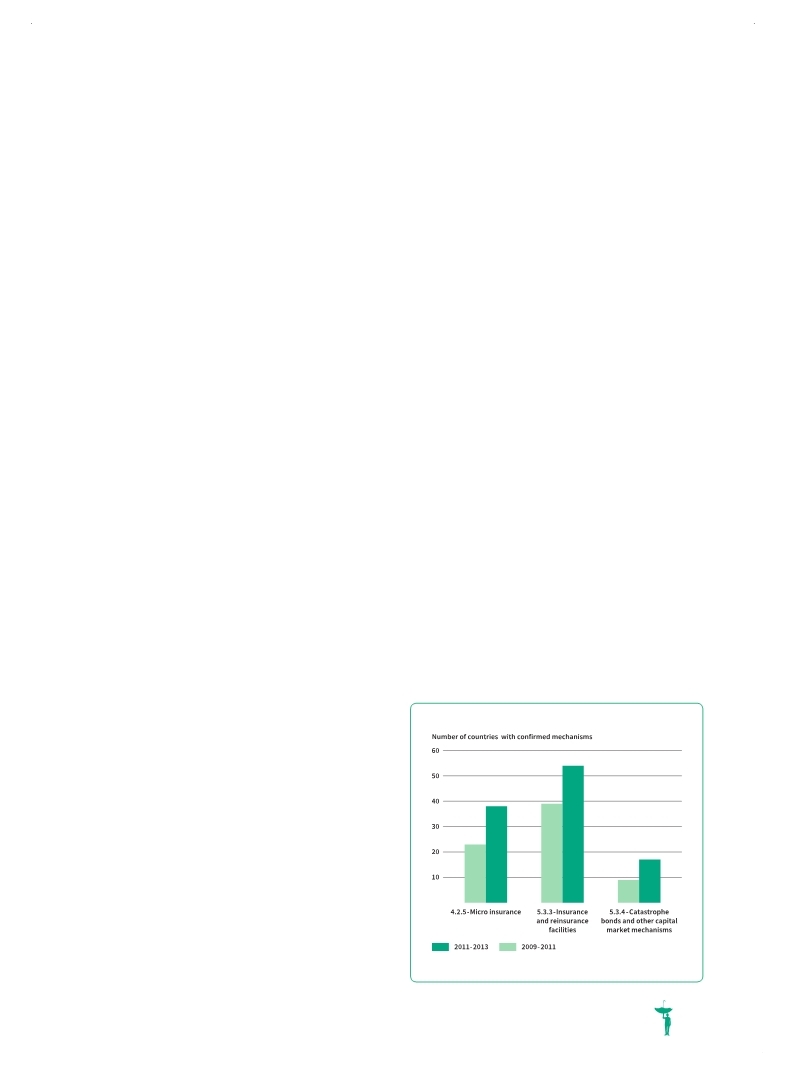 |
Global Assessment Report on Disaster Risk Reduction 2015
Making development sustainable: The future of disaster risk management |
 |
Global Assessment Report on Disaster Risk Reduction 2015
Making development sustainable: The future of disaster risk management |
|
|

193
Again, the absence of consistent output indicators makes it difficult to assess progress, but the means of verification in the HFA Monitor provide evidence of innovation, suggesting that this is an area where significant progress has been made. As a mechanism to protect social and economic development against exogenous threats, risk financing has attracted growing interest from governments, the private sector and from international organizations such as the World Bank and the OECD.
Insuring assets and business operations against risks goes back to the risk faced by seafarers in the seventeenth century. Since its beginnings at a London coffee house in 1688, where marine traders bought insurance for their goods and ships, buying and selling disaster risk insurance has grown into a big business. In the early twentieth century, governments began to promote insurance as a way of strengthening resilience and avoiding social pressures for compensation. The first government insurance scheme was the US Federal Crop Insurance Program of the 1930s, which sought to protect farmers from the double effects of the Great Depression and the Dust Bowl (
 GFDRR, 2014b GFDRR, 2014b GFDRR (Global Facility for Disaster Reduction and Recovery). 2014b,Financial Protection Against Natural Disasters, Background Paper prepared for the 2015 Global Assessment Report on Disaster Risk Reduction. Geneva, Switzerland: UNISDR.. GFDRR (Global Facility for Disaster Reduction and Recovery). 2014b,Financial Protection Against Natural Disasters, Background Paper prepared for the 2015 Global Assessment Report on Disaster Risk Reduction. Geneva, Switzerland: UNISDR.. Click here to view this GAR paper. By the early twenty-first century, several mature domestic insurance markets had evolved, for example in Japan, the United States of America (most notably in California), Turkey and Mongolia, but only a limited number of high-income countries used catastrophe risk insurance to hedge their sovereign risk and to ensure financial liquidity in the case of a large-scale emergency (
 GFDRR, 2014b GFDRR, 2014b GFDRR (Global Facility for Disaster Reduction and Recovery). 2014b,Financial Protection Against Natural Disasters, Background Paper prepared for the 2015 Global Assessment Report on Disaster Risk Reduction. Geneva, Switzerland: UNISDR.. GFDRR (Global Facility for Disaster Reduction and Recovery). 2014b,Financial Protection Against Natural Disasters, Background Paper prepared for the 2015 Global Assessment Report on Disaster Risk Reduction. Geneva, Switzerland: UNISDR.. Click here to view this GAR paper. liquidity across a range of post-disaster requirements, thereby ensuring fiscal stability during a disaster event and for years afterwards (ibid.).
Interest in using insurance both as a means to strengthen disaster resilience and an incentive to invest in disaster risk reduction has grown since the adoption of the HFA. In HFA progress reports, countries give an account of their adoption of specific policies to expand insurance coverage, for instance through mandates or compulsory protection. At the national and regional level, risk pooling schemes and catastrophe bonds are becoming an increasingly common tool to manage risk. However, only a minority of countries have fully developed mechanisms to access capital markets for risk financing (Figure 9.7). The key challenge countries report is a lack of capacity in their domestic insurance sectors or limited awareness of the costs and benefits of catastrophe insurance amongst potential beneficiaries.
The key features and underlying assumptions of catastrophe insurance for homeowners, businesses and governments have undergone dramatic changes over the years, often triggered by innovations in low and middle-income countries
(Source: UNISDR.)
Figure 9.7 Progress in insuring and financing risk
|
 
Page 1Page 10Page 20Page 30Page 40Page 50Page 60Page 70Page 80Page 90Page 100Page 110Page 120Page 130Page 140Page 150Page 160Page 170Page 180Page 183Page 184Page 185Page 186Page 187Page 188Page 189Page 190Page 191Page 192Page 193Page 194->Page 195Page 196Page 197Page 198Page 199Page 200Page 201Page 202Page 203Page 204Page 205Page 206Page 207Page 210Page 220Page 230Page 240Page 250Page 260Page 270Page 280Page 290Page 300Page 310
|
|
 
|
 
|
